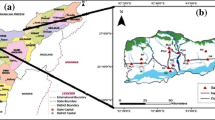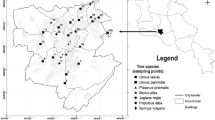Abstract
Polychlorodibenzeno-dioxins and polychlorodibenzeno-furans (PCDD/Fs) are considered among the most toxic compounds on earth. The aim of the present study was to evaluate atmospheric PCDD/F deposition and identify the areas with greater deposition of these compounds in an important industrialized and urbanized region of Portugal, using lichens as biomonitors. For this purpose, samples of the lichen Xanthoria parietina were collected at 60 sampling sites, covering urban, industrial, forestry and agriculture areas, and analyzed for PCDD/Fs, sulfur, nitrogen, zinc, iron, chromium, lead, cobalt, nickel, copper, calcium, manganese, magnesium and potassium. The concentrations of PCDD/Fs in lichens were compared with the other elements and related to land-use and population density. The results obtained through the geostatistical interpolations and after principal component analysis have shown that PCDD/F deposition estimated by lichens is greater near industrial and highly populated urban areas. We found that lichens are suitable biomonitors of PCDD/F atmospheric deposition and can contribute to a better knowledge of air quality in a region, enabling identification of critical pollutant deposition areas.
Similar content being viewed by others
References
Alcock, R. E., Sweetman, A. J., Anderson, D. R., Fischer, R., Jennings, R. A., and Jones, K. C., 2002: Using PCDD/F congener patterns to determine the source of elevated TEQ concentrations in cows milk: A case study, Chemosphere 46, 383–391.
Alcock, R. E., Sweetman, A. J., Anderson, D. R., Fischer, R., Jennings, R. A., and Jones, K. C., 2002: Using PCDD/F congener patterns to determine the source of elevated TEQ concentrations in cows milk: A case study, Chemosphere 46, 383–391.
Alcock, R. E., Sweetman, A. J. and Jones, K. C., 2001: A congener-specific PCDD/F emissions inventory for the UK: Do current estimates account for the measured atmospheric burden? Chemosphere 43, 183–194.
Anderson, D. R. and Fischer, 2002: Sources of dioxins in United Kingdom. The steel industry and other sources, Chemosphere 46, 371–381.
Ballschmiter, K., Buchert, H., Niemezyk, R., Munder, A., and Swerev, M., 1986: Automobile exhausts vs. Municipal waste incineration as sources of polychloro-dibenzodioxins (PCDD) and furans (PCDF) found in the environment, Chemosphere 15, 901–915.
Buckley-Golder, D., 1999: Compilation of EU dioxin exposure and health data, Task 1, AEA Technology, Oxfordshire, pp. 12–13.
Buekens, A., Stieglitz, L., Hell, K., Huang, H., and Segers, P., 2001: Dioxins from thermal and metallurgical processes: Recent studies for the iron and steel industry, Chemosphere 42, 729–735.
Calamari, D., Bacci, E., Focardi, S., Gaggi, C., Morosini, M., and Vighi, M., 1991: Role of plant biomass in the global environmental portioning of chlorinated hydrocarbons, Environ. Sci. Technol. 25, 1489–1495.
Chang, M. B., Chang, S. H., Chen, Y. W., and Hsu, H. C., 2004: Dioxin emission factors for automobiles from tunnel air sampling in Northern Taiwan, Sci. Total Environ. 325, 129–138.
Cicek, A. and Koparal, A. S., 2003: The assessment of air quality and identification of the pollutant sources in the Eskisehir region Turkey using Xanthoria parietina (L.) Th. Fr. (1860), Fresen. Environ. Bull. 12(1), 24–28.
Coutinho, M., Boia, C., Borrego, C., Mata, P., Costa, J., Rodrigues, R., Gomes, P., and Neves, M., 1999: Environmental baseline levels of dioxins and furans in the region of Oporto, Organohalogen Compd. 43, 131–136.
Coutinho, M., Conceição, M., Borrego, C., and Nunes, M., 1998: Atmospheric impact assessment and monitoring of dioxin emissions of municipal solid waste incinerators in Portugal, Chemosphere 37, 2119–2126.
Davy, C. W., 2004: Legislation with respect to dioxins in the workplace, Environ. Int. 30, 219–233.
Domingo, J. L., Granero, S., and Schuhmacher, M., 2001: Congener profiles of PCDD/Fs in soil and vegetation samples collected near to a municipal waste incinerator, Chemosphere 43, 517–524.
Domingo, J. L., Schuhmacher, M., Agramunt, M. C., Llobet, J. M., Rivera, J., and Müller, L., 2002: PCDD/F levels in the neighbourhood of a municipal solid waste incinerator after introduction of technical improvements in the facility, Environ. Int. 28, 19–27.
Domingo, J. L., Schuhmacher, M., Müller, L., Rivera, J., Granero, S., and Llobet, J. M., 2000: Evaluating the environmental impact of an old municipal waste incinerator: PCDD/F levels in soil and vegetation samples, J. Hazard. Mater. 76, 1–12.
Gaio-Oliveira, G., Branquinho, C., Máguas, C., and Correia, O., 1999: Spatial impact of atmospheric dust from a cement mill in Serra da Arrábida using lichens as biomonitors, Revista de Biologia 17, 33–42.
Gaio-Oliveira, G., Branquinho, C., Máguas, C., and Martins-Loução, M. A., 2001: The concentration of nitrogen in nitrophilous and non-nitrophilous lichen species, Symbiosis 31, 187–199.
Garty, J., 2000: Environment and elemental content in lichens, in B. Markert and K. Friese (eds.), Trace Elements – Their Distribution and Effects in the Environment, Elsevier Science, Amsterdam, pp. 245–276.
Guidotti, M., Stella, D., Owczarek, M., De Marco, A., and De Simone, C., 2003: Lichens as polycyclic aromatic hydrocarbon bioaccumulators used in atmospheric pollution studies, J. Chromatogr. A 385, 185–190.
Hagenmaier, H., Dawidowsky, N., Weberru, B. U., Hutzinger, O., Schwind, K. H., and Thomas, H., 1990: Emission of polychlorinated dibenzodioxins and dibenzofurans from combustion engines, Organohalogen Compd. 2, 329–334.
Herzig, R., 1989: Multi-residue analysis with passive biomonitoring: A new approach for volatile multi-elements, heavy metals and polycyclic aromatic hydrocarbons with lichens in Switzerland and the Principality of Liechtenstein, in B. Markert (ed.), Plants as Biomonitors, Indicators for Heavy Metals in the Terrestrial Environment, Weinheim, pp. 285–328.
INE, 2004: Instituto Nacional de Estatística, Portugal (http://www.ine.pt).
Lohman, K. and Seigneur, C., 2001: Atmospheric fate and transport of dioxins: Local impacts, Chemosphere 45, 161–171.
Lovett, A. A., Foxall, C. D., and Chewe, D., 1997: PCB and PCDD/F congeners in locally grown fruit and vegetable samples in Wales and England, Chemosphere 34, 1421–1436.
Oehme, M., Larssen, S., and Brevik, E. M., 1991: Emission factors of PCDD/CDF for road vehicles obtained by a tunnel experiment, Chemosphere 23, 1699–1708.
Ogura, I., Masunaga, S., and Nakanishi, J., 2001: Atmospheric deposition of polychlorinated dibenzo-p-dioxins, polychlorinated dibenzofurans, and dioxin-like polychlorinated biphenyls in the Kanto Region, Japan, Chemosphere 44, 1473–1487.
Ormrod, D. P., 1984: Impact of trace metal pollution on plants, in M. Treshow (ed.), Air Pollution and Plant Life, Wiley, New York, pp. 291–319.
Owczarek, M., Guidotti, M., Blasi, G., De Simone, C., De Marco, A., and Spadoni, M., 2001: Traffic pollution monitoring using lichens as bioaccumulators of heavy metals and policyclic aromatic hydrocarbons, Fresenius Environ. Bull. 10(1), 42–45.
Quaß, U., Fermann, M., and Bröker, G., 2004: The European dioxin air emission inventory project – Final results, Chemosphere 54, 1319–1327.
Saquid, M., Alam, I., El-Mubarek, A., and Al-Mohdar, H. M., 1989: Preliminary evaluation of mettal pollution from wear of auto tires, Bull. Environ. Contam. Toxicol. 42, 743–748.
Sarret, G., Manceau, A., Cuny, D., Haluwyn, C., Déruelle, S., Hazemann, J. L., Soldo, Y., Eybert-Bérard, L., and Menthonnex, J. J., 1998: Mechanisms of lichen resistence to metallic pollution, Environ. Sci. Technol. 32, 3325–3330.
Scerbo, R., Ristori, T., Possenti, L., Lampugnani, L., Barale, R., and Barghigiani, C., 2002: Lichen (Xanthoria parietina) biomonitoring of trace element contamination and air quality assessment in Pisa Province (Tuscany, Italy), Sci. Total Environ. 286, 27–40.
Schmid, P., Gujer, E., Zennegg, M., and Studer, C., 2003: Temporal and local trends of PCDD/F levels in cow’s milk in Switzeland, Chemosphere 53, 129–136.
Schuhmacher, M., Bocio, A., Agramunt, M. C., Domingo, J. L., and Kok, H. A. M., 2002: PCDD/F and metal concentrations in soil and herbage samples collected in the vicinity of a cement plant, Chemosphere 48, 209–217.
Silberstein, L., Siegel, B. Z., Siegel, S. M., Mukhtar, A., and Galun, M., 1996a: Comparative studies on Xanthoria parietina, a pollution-resistent lichen, and Ramalina duriaei, a sensitive species. I. Effects of air pollution on physilogical processes, Lichenologist 28, 355–365.
Silberstein, L., Siegel, B. Z., Siegel, S. M., Mukhtar, A., and Galun, M., 1996b: Comparative studies on Xanthoria parietina, a pollution-resistent lichen, and Ramalina duriaei, a sensitive species. I. Evaluation of possible air pollution-protection mechanisms, Lichenologist 28, 367–383.
Statistical StatSoft, Inc., 1995: Version 5.1 for Windows.
Stone, S. F., Freitas, M. C., Parr, M. R., and Zeisler, R., 1995: Elemental characterization of a candidate lichen research material – IAEA 336, Fresen. J. Anal. Chem. 352, 277–281.
Umlauf, G., Mano, S., Hiller, B., Barbiere, M., and Facchetti, S., 1999: Recent dioxin levels in zone A of Seveso: Northern part of the Bosco delle Querce and the soil covering the landfills Collina di Meda and Collina di Seveso, Moni. Epidemio. Remediation, 155–166.
Villeneuve, J., Fogelqvist, E., and Cattini, C., 1988: Lichens as bioindicators for atmospheric pollution by chlorinated hydrocarbons, Chemosphere 17, 399–403.
Ward, N. I., 1989: Multielement contamination of British motorways environments, in J. P. Vernet (ed.), Heavy Metals in the Environment, Vol. 1, CEP Consultants, Edinburgh, pp. 174–176.
Wevers, M., De Fre, R., and Rymen, T., 1992: Dioxins and dibenzofurans in tunnel air, Organohalogen Compd. 9, 321–324.
Author information
Authors and Affiliations
Corresponding author
Rights and permissions
About this article
Cite this article
Augusto, S., Pinho, P., Branquinho, C. et al. Atmospheric Dioxin and Furan Deposition in Relation to Land-Use and Other Pollutants: A Survey with Lichens. J Atmos Chem 49, 53–65 (2004). https://doi.org/10.1007/s10874-004-1214-y
Issue Date:
DOI: https://doi.org/10.1007/s10874-004-1214-y




